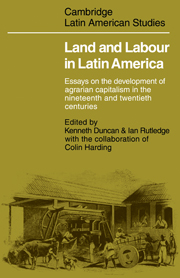 Land and Labour in Latin America
Land and Labour in Latin America Published online by Cambridge University Press: 07 May 2010
The final chapter sets the preceding papers in the wider context of the general social and economic history of Latin America in the independence period, and in this way it provides a useful framework within which to place each of the individual essays. After a consideration of some of the theoretical problems underpinning any definition of the peasantry, Magnus Mörner poses some major questions concerning the nature of Latin American economic development and the attempts at diversification in the second quarter of the nineteenth century. His analysis of the differing characteristics of each of the major crops or crop/livestock combinations considered in this volume highlights some of the general theoretical issues raised in the Introduction. He stresses, for example, how the ecological and demographic variables associated with coffee production have allowed the development of a great variety of forms of social and economic organization and modes of production. This contrasts markedly with the case of sugar cultivation, where the technological imperative has been so much more compelling, and where a more uniform system of production and labour relations has been evolved. Clearly ecology and demography are two major explanatory variables to be considered in any analysis of the process of agrarian change. Their importance is emphasized in the final part of the discussion, on the evolution of the traditional hacienda, when Mörner considers the nature of the relations between ‘landlords’ and the internal and external peasantry.
To save this book to your Kindle, first ensure no-reply@cambridge.org is added to your Approved Personal Document E-mail List under your Personal Document Settings on the Manage Your Content and Devices page of your Amazon account. Then enter the ‘name’ part of your Kindle email address below. Find out more about saving to your Kindle.
Note you can select to save to either the @free.kindle.com or @kindle.com variations. ‘@free.kindle.com’ emails are free but can only be saved to your device when it is connected to wi-fi. ‘@kindle.com’ emails can be delivered even when you are not connected to wi-fi, but note that service fees apply.
Find out more about the Kindle Personal Document Service.
To save content items to your account, please confirm that you agree to abide by our usage policies. If this is the first time you use this feature, you will be asked to authorise Cambridge Core to connect with your account. Find out more about saving content to Dropbox.
To save content items to your account, please confirm that you agree to abide by our usage policies. If this is the first time you use this feature, you will be asked to authorise Cambridge Core to connect with your account. Find out more about saving content to Google Drive.